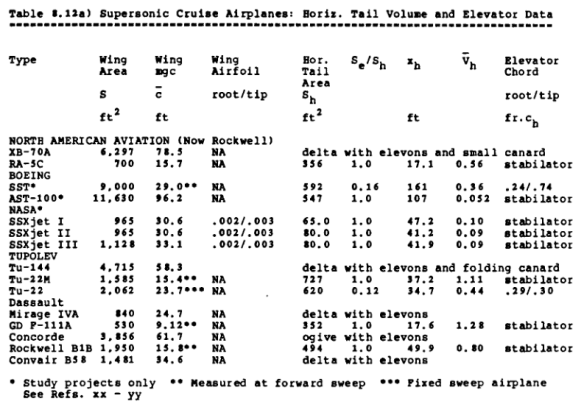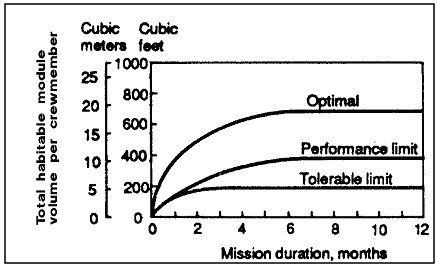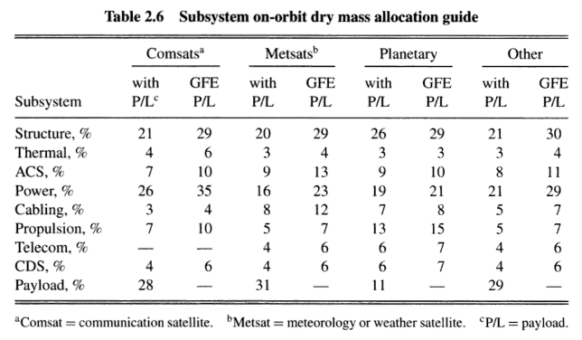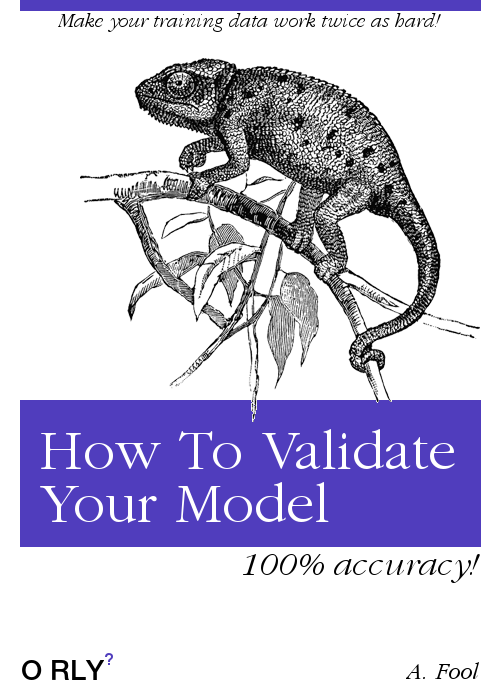[Epistemic Status: Speculative]
Technical types often have to make relatively important decisions with relatively little in the way of theory or constraint to inform their choices. When this occurs, we will often us the decisions which designers made previously as a starting point. I’m not sure if there’s a formal name for this technique; I call it historical inference.
Have a few examples so you’ll know what I’m talking about.
1. Airplane Control Surfaces: Determining the size and locations of the flaps, ailerons, elevators, and rudders that control an airplane’s orientation is a complex, iterative problem. Analyzing control surfaces that are already present is a great deal easier, mathematically, so for preliminary airplane design we would prefer to guess and check. Simply throwing numbers at the board, however, will take a long time to generate an acceptable answer. Making intelligent guesses is a non-trivial fraction of the battle.

Roskam, J., Airplane Design Part II: Preliminary Configuration Design and Integration of the Propulsion System, 4th printing, DARCorporation, Lawrence, KS, 2004.
An easy way to get better guesses is to look at airplanes with a comparable configuration and role. (For examples, amphibians, or supersonic cruise aircraft.) Designers can look for trends or similarities and use numbers within that range as an initial guess. More advanced aerodynamic and stability analysis can then revise these numbers.
2. Spacecraft Mass and Power Requirements: Usually, a space mission will start with a payload, and a spacecraft will be designed to deliver it. For instance, we might want to put a telecommunications relay in geostationary orbit, or a set of instruments on the surface of another planet.

Brown, C. D., Elements of Spacecraft Design, edited by J. S. Przemieniecki, AIAA Education Series, AIAA, Reston VA, 2003.
Since the payload is often known fairly early in the process, designers may use the mass and power requirements of the payload to estimate the same parameters for the larger vehicle. It is safest to divide these into categories—communications satellites will operate quite distinctly from weather satellites, and planetary probes will have different needs entirely. (This comes with the risk of smaller sample sizes, so we may opt to use the full set of spacecraft we have data for.) Regardless, we can look at past relationships and attempt to derive some broad trends.
3. Crew Habitat Volume: Human beings need a certain amount of space to themselves, and nowhere is that more obvious than when outside is utterly inhospitable to human life. For short flights, such at re-entering the atmosphere, a human being can tolerate extremely small volumes, but a mission to Mars would require dramatically more room.

The Celentano curves for pressurized volume in crewed spacecraft.
Source: NASA
The pressurized volumes of crewed spacecraft are often predicted using the Celentano curve, which posits certain thresholds against which to allocate volumes for long duration confinements.
All three of these examples represent what we might call quasi-empirical guidelines: looking at what has been done before and using that to predict future requirements.
When no other information is available, this is often a good approach. For instance, if you’re embarking on a time-intensive project, you should look at how well you (and others) have handled projects of a similar scale and scope. Don’t assume that your schedule is magically immune from planning fallacy just because it happens to be yours.
When better data or theories are available, however, historical inference runs the risk of becoming a self-fulfilling prophecy.
Take again those airplane control surfaces. Roskam gives us what is presumably a representative sample of aircraft in each category up to the time he published Airplane Design (the late 1980s). We can check them against physical principles, but often embedded in the equations are assumptions based on the hardware capabilities of the day.
Or look at those satellite mass and power estimates from Brown. These, too, represent a small, hopefully representative sample. From these, we can estimate the mass and power breakdowns within each category of spacecraft, with different numbers depending on whether the payload is government furnished equipment (GFE).

Brown, C. D., “System Engineering”, Elements of Spacecraft Design, edited by J. S. Przemieniecki, AIAA Education Series, AIAA, Reston VA, 2003.
But this reflects the technological capability of the various system components over a particular span of time. If, say, materials science advances more quickly in structural metals than solar panels, then the mass distribution within the vehicle should change. Or, perhaps, equivalent computers now require less power compared to equivalent actuators. The breakdown will need an update.
Airplane and satellite development are sufficiently competitive, thankfully, that designers are unlikely to leave weight, power, or reliability savings on the table; they’re more likely to write a technical paper explaining their idea to the industry. Engineers will usually test new hardware to see whether it will stand up to the design conditions and then some, eventually establishing a new baseline. The relations in Brown, Roskam, and similar texts are generally intended for broad preliminary design; professional organizations will maintain their own, more up-to-date databases.
But what about crewed spacecraft development, which moves at a much slower pace? Celentano’s paper was originally published in the early 1960s. The curve is based on a handful of short-duration ground tests with relatively few occupants, and then extrapolated to multi-year expeditions. Researchers in the intervening period have critiqued the model in numerous ways, but the Celentano curve remains deeply embedded in the literature.
A 2008 paper attempts to test the Celentano curve against the spacecraft which had actually flown up to that date, but the validity of that analysis is unclear without known the extent to which the curve was used in their design process. If later vehicles based their pressurized volumes heavily on that curve, then we’re just trying to test the regression with the original inputs.
This risk is especially true when we include future designs in our data set; many conceptual spacecraft use the Celentano curve even though there’s ultimately very little empirical evidence behind it. Better testing in ground analogues against operational criteria for astronaut performance is really necessary before we can say that it represents a meaningful guideline for sizing crewed spacecraft.
All this said, I don’t want to come across too critical of historical inference. My original title for this post was “Beware Historical Inference”, but that’s really too strong. Looking at past data is a good technique for getting preliminary estimations at the start of new projects, provided you keep in mind the data’s limitations. Some data is usually so much better than no data that even if you’re making up numbers, doing math with made up numbers is better than not doing math at all.
I really want you to be aware of where your data comes from, and understand the limitations of any particular heuristic. (This won’t be perfectly possible, but try anyway.) All sorts of regressions do a decent job predicting outcomes within their range of application, but go wild outside the stated limits, for the simple reason that these are extremely coarse models. Capturing all the higher-order details is hard.
Maybe certain factors are only relevant below a certain point; maybe other become relevant above a different point. The decontextualized data we’re looking at is normally a rough average over a certain range, not a fundamental natural law. Without knowing the actual, underlying physical principles, you won’t know if the regression is still valid outside the stated range.
For technical questions, it’s usually feasible to test the validity of the model in some way or another. This becomes less true the further we move away from prototype physical systems. Will your next romantic relationship follow the same pattern as with your ex? Will changing jobs actually make you happier? How much disruption will any sort of major life change actually cause?
These are not easy questions to answer—you have a limited sample size of past experience and a lot of relevant factors that shouldn’t just be smoothed into a couple of variables. Over the years, technical communities have learned what they do and don’t need to consider when making predictions. Sometimes, the lessons are easy. Sometimes, they are very hard.
You have the advantage of others’ past experience, if you can look past the perceptual level and tease out the causal connections underneath.
Let’s get started right now. Can you think up any examples where using historical inference would be appropriate in your personal life? What sort of edge conditions would make those heuristics run amok? How can you tell?
References
- Brown, C. D., “System Engineering”, Elements of Spacecraft Design, edited by J. S. Przemieniecki, AIAA Education Series, AIAA, Reston VA, 2003.
- Cohen, M. M., “Testing the Celentano Curve: An Empirical Survey of Predictions for Human Spacecraft Pressurized Volume”, SAE International Journal of Aerospace, Vol. 1, No. 1, 2008, pp. 107–142.
- Roskam, J., “Class I Method for Empennage Sizing and Disposition and for Control Surface Sizing and Disposition”, Airplane Design Part II: Preliminary Configuration Design and Integration of the Propulsion System, 4th printing, DARCorporation, Lawrence, KS, 2004.

